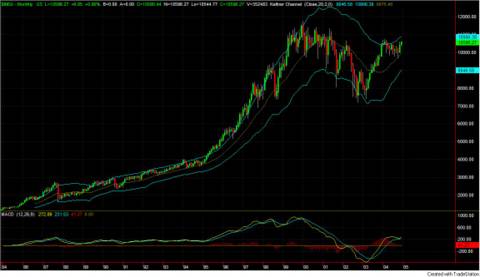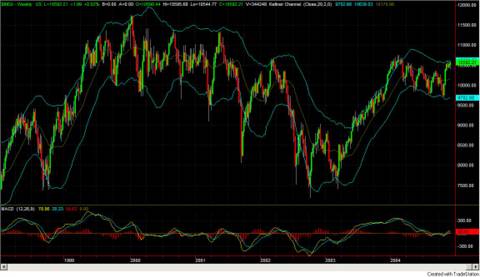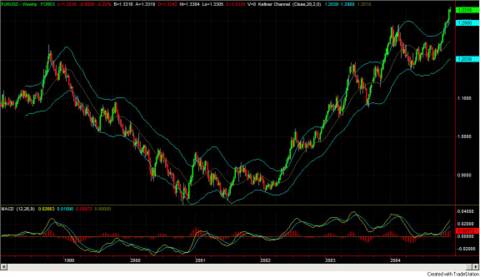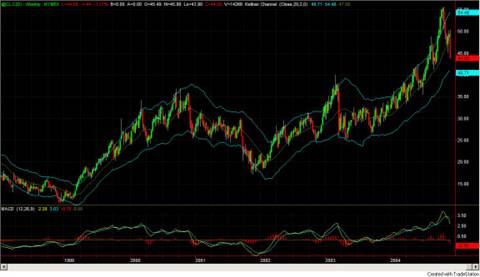Tuesday, December 21, 2004
Buried Time Series Data on Employment
Here's today's latest Bureau of Labor Statistics report on Regional and State Employment and Unemployment. BLS Regional & State Employment Nov 2004
These reports on based on detailed time series covering many, many variables. Unfortunately, any trends taking place are buried deeply and hidden from view. This 16 page report does not have a single time series chart to show the trends that may or may not be underway. For those who are not faint of heart and love looking at complex tabular data and have lots of time, there are several detailed tables that contain partial time series data for review. There are also a couple of hard to read geographical charts showing current state by state changes in the past 12 months (a implicit time series with only 2 data points).
For those with the time and interest and high speed links and skills, the full time-series can be downloaded, massaged, and analyzed. For the rest of us, we are left with inconclusive text such as the opening summary paragraph:
REGIONAL AND STATE EMPLOYMENT AND UNEMPLOYMENT: NOVEMBER 2004
Regional and state unemployment rates were generally little changed in November. All four regions and 47 states and the District of Columbia recorded changes in their jobless rates of 0.3 percentage point or less from October, the Bureau of Labor Statistics of the U.S. Department of Labor reported today. Over the year, jobless rates declined in all four regions and in 42 states. The national unemployment rate was essentially unchanged over the month at 5.4 percent in November. Nonfarm payroll employment increased in 35 states and the District of Columbia over the month.
This seems to be saying that everything is ok and maybe even good without actually coming out and saying it. The statistics they quote would seem to imply that not much of interest is happening in the regions or the states, that there has been some improvement in the past year (but compared to what), and that employment has grown (but not by how much or compared to anything).
The Economic Policy Institute (EPI) Job Watch takes a look at the same data and comes up with something a lot shorter and a little more user friendly as you can see at: EPI JobWatch: State data and organizations. They also look like they are trying to dig out more interesting facts from the same data, all with a strong point of view that says things really aren't going very well.
Take a look at both of these and see what you think. Who's right? Who's wrong? Who offers more food for thought? Who challenges the reader with more provocative claims?
In neither case, are any of the time series available for easy viewing, so the reader is left depending on the opposing expert writers who prepared these documents or going to a lot of time and trouble trying to actually look at the real data.
Both approaches use what amounts to time-series with exactly two data points and avoid showing us any of the data collected between these two points, or any prior to the earliest points.
Neither leaves me particularly satisfied. Who do I trust when the experts disagree so widely and the data is not readily available?
I would really like to know how our country is doing and what is happening with employment. Are we moving towards a time when we can create enough jobs to keep up with growth in working age population? This is a topic addressed by EPI but completely off the radar in the BLS report.
The EPI main page at: JobWatch does indeed use some time-series to make their points and this is an improvement in my eyes. Still the reader is left mostly dependent on who do they trust when the data reported is so limited.
Finally, take a look at the White House Jobs and Economic Growth: "The State of Our Economy" for yet another way to assess the employment situation. Notice the absence of time series data, and the use of carefully selected two point time series described in words.
Examining cases such as these in near real time, can be instructive in triggering our thinking about how important information can be communicated in a way that gives the reader, viewer, or listener a better chance of judging the facts for themsleves.
Saturday, December 18, 2004
Which View is Correct?
Looking at the Dow Jones Industrial Average through the lens of these different view can be confusing at first. Which view is correct? Why do they look so different? What are they trying to tell me?
This is the time series visual equivalent of the blind men and the elephant story. Each view tell a different part of the story, literally from a different view point. Each view is only part of "THE TRUTH" of the matter. It's up to us to use these visualizations of behavior over time, to help craft a story that is consistent with each different viewpoint and helps tie them together.
Different observers will bring different experience and knowledge about other parts of the world to the table when reviewing these pictures and will as a result craft different stories.
The beauty of the visualized time series approach is that it opens up the possibility for us to sit down together, to view the series together, to share our explanations and stories with each other, to learn from one another. As this process unfolds as we sit side by side in either physical space or virtual space, the doors are open to collaboration. The opportunities are there for us to develop a new and better stories, to bring new facts and time series into the picture, and to develop new ground for common understanding and common action.
Which view is correct? They all are. It's up to us to fit them together.
Where do we go from here? Here's a beginning
The Dow is only a single measure of financial behavior. Even with only a single metric, we have so many choices.
1) we see we can look at it's raw value as reported on the nightly news completely out of context of its life history.
2) we can look at it's behavior over 5 years or 20 years, or for that matter for 1 year, for 1 month, for 1 week, for 1 day, or for 1 hour. Each of these zoomed in or zoomed out views will give us perspective about what's happening.
3) we can normalize its value in terms of some other metric such as the value of the dollar vs. the euro.
4) we could also normalize it terms of inflation as we commonly do with some other metrics such as Gross Domestic Product or Average wages
5) And we can bring into play one or two or a hundred other important measures of financial behavior such as GDP, Wages, Unemployment, interest rates, trade balances, national debt, other currencies vs. the dollar. And each of these can have its own zoomed or unzoomed values, and its own variants and formulaic calculations.
Then our job is to sit with the question we have in mind, to wander through a subset of the combinatoric number of pictures we might view, to construct and share our stories with others who are interested in the same question and who are willing to examine the corpus of data.
The possibility for this kind of TimeLine Collaboration, yet another "TLC", is the thesis of this Blog site.
In the financial sphere, especially in the stock market and other financial markets, the ability for ordinary citizens to wander the visualized time series space of possibilities is quite far advanced. We can learn a lot by seeing what common web sites such as http://www.prophet.net/ offer to those interested in the time series behavior of their favorite stocks.
The value of time series visualization and collaboration is not restricted to the stock market. In any areas of our lives that are important to us, there are essential measures that change over time. Making these measures and their changing ebb and flow readily accessible and visible to ordinary citizens can make a huge difference in our ability to control our own destiny and to shape the future of our dreams.
The challenge for us: Once we move outside the stock market arena, the ability for ordinary people to have access to and to visualize the important time series that exert powerful influences on their lives is reduced almost to zero.
One of the on-going missions of this Blog is radically alter the landscape, to make more and more of the vital time series available to more and more people, to make these series available in a readily reusable and visual form, and to foster collaboration, shared story telling, discussion, learning, and all the fruits that can follow from opening our eyes to the time series (mostly invisible) that are flowing all around us at every moment of our lives
Note: The source of the recent charts of the Dow Jones averages, currency markets and the like is TradeStation.
Monday, December 13, 2004
Dow Jones - A 20 Year View

Dow Jones - 20 Year View

Compare this to the 5 year view at: http://photos1.blogger.com/img/165/2326/1024/DowJonesAvg5year.jpg or to the the 5 year view normalized and denominated in Euros at: http://photos1.blogger.com/img/165/2326/1024/DOWperEURO5yearsWeekly.jpg. Each tells a different story.
Sunday, December 5, 2004
Five Year Views
Enjoy
Saturday, December 4, 2004
Describing pictures with words. No easy task.
Employment Situation Summary: "
THE EMPLOYMENT SITUATION: NOVEMBER 2004"
Employment rose in November, and the unemployment rate, at 5.4 percent, was essentially unchanged, the Bureau of Labor Statistics of the U.S. Department of Labor reported today. Nonfarm payroll employment increased by 112,000 over the month, with job gains in several service-providing industries.
Unemployment (Household Survey Data)
Both the number of unemployed persons, 8.0 million, and the unemployment rate, 5.4 percent, were about unchanged in November. The jobless rate has been either 5.4 or 5.5 percent in each month since July. This is slightly below the rates that prevailed in the first half of 2004.
In November, the unemployment rates for the major worker groups--adult men (4.9 percent), adult women (4.8 percent), teenagers (16.6 percent), whites (4.7 percent), blacks (10.8 percent), and Hispanics or Latinos (6.7 percent)--showed little or no change over the month. The unemployment rate for Asians was 4.2 percent in November, not seasonally adjusted. (See tables A-1, A-2, and A-3.)
In the PDF version, they do show graphs of two key metrics, covering 3 years. Clearly not the whole story. The rest of the document is filled with tables. Lots of good data, for those with the time, patience and interest, but still leaving out a giant swath of the underlying time series and forcing the readers to create the timeline visualizatoins in own heads (if at all).

Dow Jones Industrial Average over the past 5 years. (Please CLICK for Full Size Image). This time series picture (denominated in its default of US Dollars) is in marked contrast to the view of the same average denominated in Euros posted earlier today. This picture makes it seem that the Dow has recovered to close to 1999 through 2001 high values. This chart shows a very strong rise from January 2003 through December 2003, a slow drop off during 2004, with a recent sharp rise. Which view is "right"? My sense is that both of these charts have value and help fill in part of the picture. What else do you want to look at after seeing these two charts?


The Dow Jones Industrial Average Denominated in Euros over the past 5 years. Reached a high of 13,000 in 2000 and then again in 2001. Recoverd to a high of 12,000 in 2002 (post 9/11). Then the bottom fell out and it dropped to below 8000 in early 2003. It recovered to around 8,500 later int 2003 and has been stuck there ever since with the most recent behavior showing a decline to the 8,000 range.







